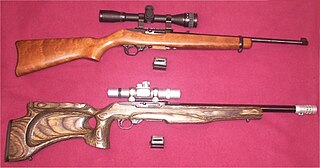Firearm modification


Firearm modification is commonly done in order to enhance various aspects of the performance of a firearm. Reasons for these modifications can range from cosmetic to functional, and can be simple operations that the owner can perform, or complex operations requiring the services of a gunsmith.
Modifications performed
Common modifications include:
- Cosmetic and ergonomic modifications
- Replacement or alteration of grips or stocks[1]
- Changing of sights, such as the adjustable iron sights or a telescopic sight[1]
- Adding or removing weight to ease carrying, alter balance, or help moderate recoil[1]
- Metal engraving or custom woodwork[1]
- Checkering or stippling wood or metal[1]
- Altering the metal finish, using techniques such as parkerizing[1]
- Use of a shorter barrel to reduce size and weight, or a longer barrel to increase velocity
- Caliber conversions
- Rechambering or rebarreling for a new caliber, such as conversions made to chamber a wildcat cartridge
- Use of a caliber conversion sleeve or other readily removable insert to fire a smaller, less expensive cartridge
- Operating mechanism conversions
- Muzzleloading or paper cartridge to metallic cartridge conversions, such as the Allin conversion or Lund conversion
- Conversion from select fire to semiautomaticonly or manual operation, or vice versa
- Short recoil to blowback conversions, used in various .22 Long Rifle conversions, such as the Colt Ace and J. A. Ceiner conversion kits.[2]
- Conversion from handgun to carbine or rifle[3]
- Addition of a rifled barrel to a shotgun to allow it to better fire shotgun slugs
- Accurizing
- Sporterizing
Some commonly customized firearms include the
bullseye pistol and benchrest shooting
also rely extensively on custom-built and modified firearms to achieve top accuracy.
Legal issues
Care must be taken when modifying firearms, as some operations may convert a legal firearm into an illegal one. An example of this is the restrictions in the US National Firearms Act, which define restricted classes of firearms. Examples of illegal firearms under this act are:
- Rifles with overall lengths under 26 inches, or barrels under 16 inches in length
- Shotguns with overall lengths under 26 inches, or barrels under 18 inches in length
- Machine guns
- A conversion to a fixed cartridge of over .50 caliber
These restrictions vary from location to location; some areas may restrict
Hughes Amendment
in 1986. Such weapons may be held only by law enforcement and military only except for "dealer samples" left in the hands of SOT holders. Fully automatic weapons converted to semi-automatic only operation are machine guns per the NFA. The BATFE's policy is "Once a machine gun, always a machine gun."
See also
References
- ^ ISBN 0-695-81212-2.
- ^ "Jonathan Arthur Ciener, Inc. .22LR Conversions". Retrieved 2007-11-28.
- ^ "Carbine conversion kits from Mec-Tec". Retrieved 2007-11-28.
- ^ "California Penal Code, Section 12090-12094". Retrieved 2007-11-28.
- ^ "California AB 1471". Retrieved 2007-11-28.
- ^ See Gun Control Act of 1968
